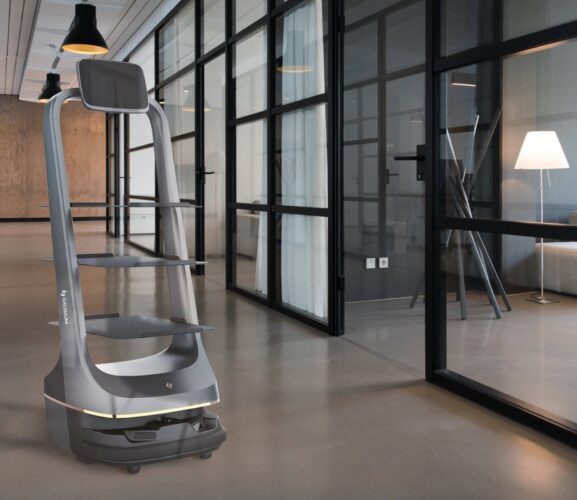UP NEXT
Gaussian Robotics Secures $188 Million In Series C FundingNovember 11, 2021

November 29, 2021
Recently, Gaussian Robotics has launched its first food delivery robot named X1, announcing the company’s entry into the field of autonomous food delivery.
For Gaussian Robotics, the R&D of autonomous food delivery solutions was never a difficult attempt, but rather a process simplified and accelerated by effective technology reuse.
Founded in 2013, Gaussian has established its name in the service robot industry with its ECOBOT series – a floor cleaning robot portfolio consisting of 6 product lines for extensive application in a variety of commercial and industrial scenarios. The investment in the R&D of robotic cleaning solutions has endowed Gaussian with strong technological capacity in navigation, specifically localization and mapping, environmental perception and path planning. These technologies can be directly applied to developing food delivery robots.

Compared with autonomous cleaning, the field of autonomous food delivery has a lower technology barrier to entry under its less demanding application scenarios. Generally, a food delivery robot is deployed at a restaurant within a few hundred square meters. Its path planning mechanism is relatively simple with its major task being moving from one point to another.
In addition to its technological edge in navigation, Gaussian has built an inclusive service robot supply chain (R&D, manufacturing, sales, and customer support, etc.) as well as a global market network across 6 continents through 8 years of endeavor. These existing assets and resources are supposed to create a remarkable cost advantage for Gaussian’s new product line of food delivery robots.
According to Gaussian, they did an in-depth market research in the catering industry when initiating the food delivery project. The research shows that operational efficiency, safety and applicability to scenarios are among the customers’ top concerns for food delivery robots. X1 is claimed to be an optimal solution to these customer pain points with its all-round performance superiority over major food delivery robots in the market.
Navigation Without QR Codes
Upon initial deployment in a restaurant, most of the food delivery robots require scanning a QR code that contains the location information of the site. The deployment process can be very time-consuming and thereby interrupts the normal operation of the restaurant. Moreover, these QR codes are placed on the ceilings of the sites, which compromises the interior aesthetics of the restaurants.

By comparison, X1 spares the hassle of placing QR codes on the ceilings, and automatically updates the map of the site when layout changes. Unlike the navigation solutions of most food delivery robots that are either laser-based or vision-based, the navigation algorithm of X1 is based on a laser-vision fusion of LiDAR and TOF camera, which offers higher accuracy of positioning and better environmental perception.
Shock Absorption by Independent Suspension System

Most of the existing food delivery robots do not have a shock absorption chassis to effectively avoid events of liquid spilling, which decreases delivery efficiency and environmental hygiene. To eliminate this drawback, X1 is developed with a vehicle-level independent suspension system to deliver high-performance vibration suppression, which ensures the smooth and stable delivery of liquid dishes.
LFP Batteries Providing Higher Safety and Longer Endurance

Most of the food delivery robots in the market are powered by ternary lithium batteries that are prone to explosion under high temperature. X1, on the other hand, adopts LFP (lithium iron phosphate) batteries that are more stable thermally and chemically, eliminating the safety hazards of overheating or explosion. LFP batteries are also marked by superb longevity with a life cycle up to 6 times longer than that of common ternary lithium batteries.
The market has proven the effectiveness of service robots in reducing labor costs, improving operational efficiency, and enabling digital management. Catering is a labor-intensive industry, with growing labor costs induced by an aging population. According to the 2021 interim report of China’s biggest hot pot chain, HaiDiLao, its staff costs increased by 75.8% in the first half of the year, accounting for 35.6% of its total revenue. Under the worldwide situation of recurrent COVID-19 outbreaks, contactless autonomous food delivery serves as a reliable solution to rising labor costs and health risks.
Entering the field of autonomous food delivery is part of Gaussian’s digital-platform strategies of service robots. The underlying technologies of these mobile service robots can be reused to enable fast and cost-efficient development. By leveraging the internal assets and competencies useful to multiple product areas and business units, Gaussian will be able to meet a wider range of market needs in the future.
About Gaussian Robotics
Founded in 2013, Gaussian Robotics (Shanghai Gaussian Automation Technology Development Co., Ltd.) is one of the world’s earliest robotic companies engaged in the R&D of autonomous driving and navigation technology. 8 years after its foundation, Gaussian has developed and launched currently the world’s most comprehensive floor cleaning robot portfolio consisting of 6 product lines covering the functions of scrubbing, sweeping, vacuuming, dust mopping, sanitizing, and crystalizing. The GS cleaning robots have been deployed in thousands of commercial, institutional and industrial facilities across 43 countries and regions to deliver professional cleaning services.
In November 2021, the company announced a $188 million Series C funding jointly led by Capital Today and SoftBank Vision Fund 2.

Step 1/2
Please select the type of business you’d like to have with Gausium.
Choose one item from the list
Step 2/2
Thanks for sharing your preference. Please fill out the form below, and we’ll get in touch shortly.
By clicking “Submit”, I authorize Gausium to contact me. Privacy Policy.
Thank you for filling out the form
By clicking “Submit”, I authorize Gausium to contact me. Privacy Policy.